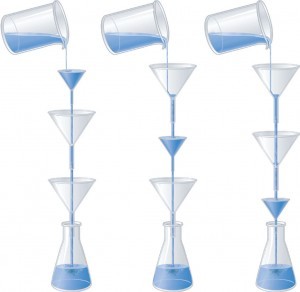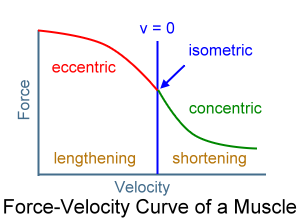Did you ever take chemistry in school? If so, you may remember something known as the rate limiting step. What this means is that when there's a chemical reaction the speed of the reaction may be limited by a particular element. Increasing the concentration of this element allows the entire reaction to happen more quickly. [caption id="attachment_5569" align="aligncenter" width="300"] With the 3 pours, the first funnel will be limited, followed by the middle series and then the 3rd series of funnel. The flow rate in each is limited by the smallest funnel. It's important to know the rate limiting or determining step because then we know where our efforts will generate a better result. Let's look a different example to see how this works. Imagine a busy restaurant that measures each day's success by the number of tables turned over. There will be a maitre-d, a hostess, a server, sous-chefs, head-chefs, bussers and dishwashers. If the dishwasher doesn't show up for work eventually the plates pile up and there will no clean plates to set a new table. Everything backs up at this point. And it doesn't matter if everyone else does a little bit more because the dishes are still piling up, not getting washed and tables are not getting turned over. We can know appreciate that when we're looking to achieve a goal there may be something that limits the outcome. With sprinting for example, we know there are contributions from the lower body joints i.e. the ankle, knee and hip. When walking there is a contribution from each of these joints. As we progress from walking to sprinting is the increased role of these joints proportional? Or are certain joints prioritized? A recent study looked to answer this question. Researchers looked at the involvement of the ankle, knee...
Post Activation Potentiation
- Chris Collins
- Fitness
- Training
- Fitness Education
- 1815 Hits
- 0 Comments
-
Speed is one those things every athlete wants more of. It may be described as quickness or having a faster first step but ultimately it comes to having more horsepower. But how we go about developing speed is a good question. Ask five different coaches what they do for speed training and you may get five different answers. Recently there was an article published in the Journal of Strength & Conditioning Research by Hancock et al which looked at how post activation potentiation (or PAP) affects swim performance. This research team took 30 collegiate swimmers and had them do a standard warm-up followed by a 6 minute rest. After the rest the swimmers performed a 100 m time trial with splits at the 50 m mark plus blood lactacte was sampled. One grip did 4x10 m maximal swims on the minute against the resistance of a power rack before taking the 6 minute break. These four swims lasted an average of seven seconds and the resistance for each swimmer was set based on their mass and 100 m swim time so as to equivalent for everyone. What they found was that performing the four maximal sprints resulted in a swim times that were 0.54 seconds faster than the group that didn't perform them. Think 0.54 s doesn't matter in the 100 m freestyle in swimming? It would if you were #11 and you were the only to perform this kind of warm-up. In theory it could shave 0.54 seconds off his time and take him from 48.67 to 48.13 and the gold medal.RankHeatLaneNameNationalityTimeNotes165Nathan Adrian United States48.19Q261Gideon Louw South Africa48.29Q382Sebastiaan Verschuren Netherlands48.37Q484James Magnussen Australia48.38Q585Brent Hayden Canada48.51Q667Brett Fraser Cayman Islands48.54Q678Pieter Timmers Belgium48.54Q, NR863Nikita Lobintsev Russia48.60Q987Cullen Jones United States48.61Q1077Konrad Czerniak Poland48.63Q1164César Cielo Brazil48.67Q1274James Roberts Australia48.93QI point this out to show that a half second...
Yoga - Is It Good for Athletes?
Everything we do with our clients has to serve a purpose.The foam roll drills and stretches need to facilitate increased mobility. The nutritional plans need to provide the essential nutrients, energy and hydration. And the training plans need to fit the needs, goals and abilities of the individual doing the work.So I'm always curious as to why people go to yoga?A quick google search lead me to healthyyoga.com with the Top 10 Benefits of Yoga. Their list includes:1. Stress Relief 2. Pain Relief 3. Better Breathing 4. Flexibility 5. Increased Strength 6. Weight Management 7. Improved Circulation 8. Cardiovascular Conditioning 9. Focus on the Present 10. Inner Peace***I'll look at 4,5 & 8 below. The rest are fairly subjective and therefore difficult to measure.***There is no doubt that a number of people practice yoga but I'm always curious as to their reasons? I look at everything that our clients do as being beneficial and purposeful.And yoga has me perplexed.Because I hear constantly of the purported benefits of yoga. And especially the benefits it lends to sports performance.In fact there is power yoga which sounds like it would be perfectly suited to athletes that are seeking more power and to move more quickly.But power is the definition of the amount of work done per unit time. And work is equal to a force applied over a distance. So you need to move a substantial force quickly over some distance to train for power. Holding bodyweight poses for extended periods of time hardly meets the criteria for power development.Case in point India has one, count it one, individual gold medal in the history of the Olympics. Ever. And by the way that gold medal came in air rifle. Hardly a sport requiring power. Well, a powerful gun maybe :)In a similar sense to the...


